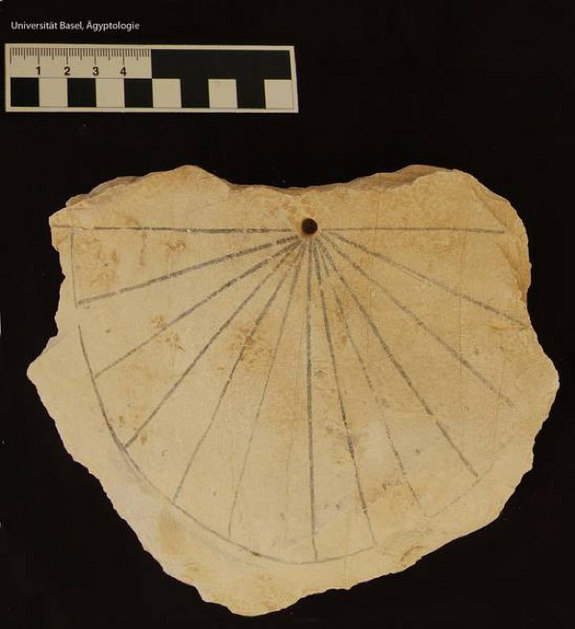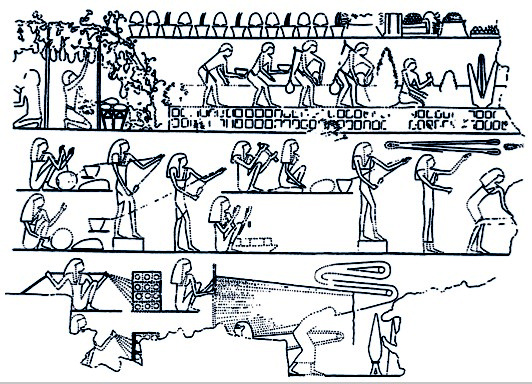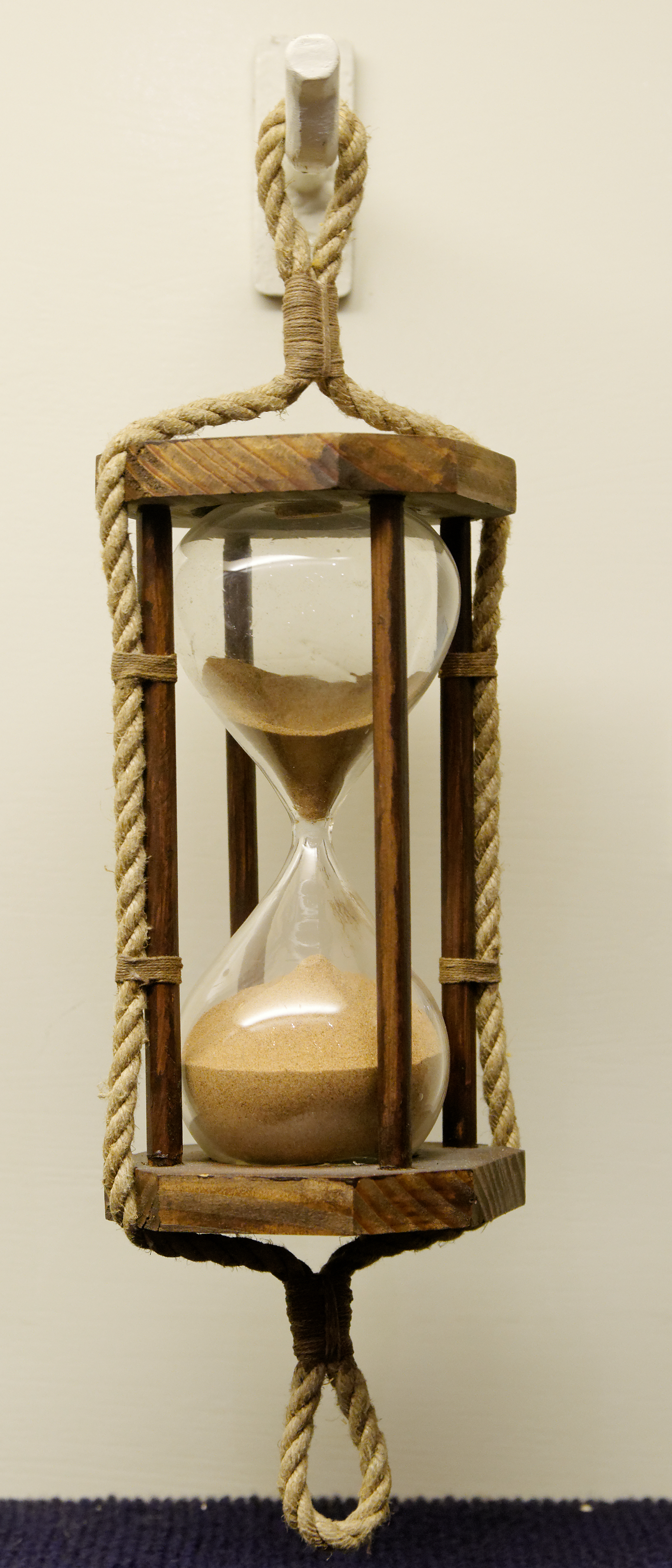|
History Of Timekeeping Devices In Egypt
The ancient Egyptians were one of the first cultures to widely divide days into generally agreed-upon equal parts, using early timekeeping devices such as sundials, shadow clocks, and merkhets ( plumb-lines used by early astronomers). Obelisks were also used by reading the shadow that they make. The clock was split into daytime and nighttime, and then into smaller hours. Sundials and shadow clocks Despite Herodotus's attribution of the invention of the sundial to the Babylonians in 430 BCE, the earliest known sundials were simple gnomons of Egyptian origin invented around 3500 BCE . More complex devices were developed over time, the earliest surviving one is a limestone sundial that dates back to 1500 BCE, discovered in the Valley of the Kings in 2013. It was found in a housing area of construction workers and its division of daytime into 12 parts was possibly used to measure work hours. Shadow clocks were modified sundials that allowed for greater precision in determining the t ... [...More Info...] [...Related Items...] OR: [Wikipedia] [Google] [Baidu] |
Obelisk
An obelisk (; from grc, ὀβελίσκος ; diminutive of ''obelos'', " spit, nail, pointed pillar") is a tall, four-sided, narrow tapering monument which ends in a pyramid-like shape or pyramidion at the top. Originally constructed by Ancient Egyptians and called ''tekhenu'', the Greeks used the Greek term to describe them, and this word passed into Latin and ultimately English. Ancient obelisks are monolithic; they consist of a single stone. Most modern obelisks are made of several stones. Ancient obelisks Egyptian Obelisks were prominent in the architecture of the ancient Egyptians, and played a vital role in their religion placing them in pairs at the entrance of the temples. The word "obelisk" as used in English today is of Greek rather than Egyptian origin because Herodotus, the Greek traveler, was one of the first classical writers to describe the objects. A number of ancient Egyptian obelisks are known to have survived, plus the " Unfinished Obelisk" found part ... [...More Info...] [...Related Items...] OR: [Wikipedia] [Google] [Baidu] |
Ancient Egyptian Technology
Ancient Egyptian technology describes devices and technologies invented or used in Ancient Egypt. The Egyptians invented and used many simple machines, such as the ramp and the lever, to aid construction processes. They used rope trusses to stiffen the beam of ships. Egyptian paper, made from papyrus, and pottery were mass-produced and exported throughout the Mediterranean Basin. The wheel was used for a number of purposes, but chariots only came into use after the Second Intermediate Period. The Egyptians also played an important role in developing Mediterranean maritime technology including ships and lighthouses. Technology in Dynastic Egypt Significant advances in ancient Egypt during the dynastic period include astronomy, mathematics, and medicine. Their geometry was a necessary outgrowth of surveying to preserve the layout and ownership of fertile farmland, which was flooded annually by the Nile River. The 3,4,5 right triangle and other rules of thumb served to r ... [...More Info...] [...Related Items...] OR: [Wikipedia] [Google] [Baidu] |
Ancient Egyptian Science
The history of science covers the development of science from ancient times to the present. It encompasses all three major branches of science: natural, social, and formal. Science's earliest roots can be traced to Ancient Egypt and Mesopotamia around 3000 to 1200 BCE. These civilizations' contributions to mathematics, astronomy, and medicine influenced later Greek natural philosophy of classical antiquity, wherein formal attempts were made to provide explanations of events in the physical world based on natural causes. After the fall of the Western Roman Empire, knowledge of Greek conceptions of the world deteriorated in Latin-speaking Western Europe during the early centuries (400 to 1000 CE) of the Middle Ages, but continued to thrive in the Greek-speaking Eastern Roman (or Byzantine) Empire. Aided by translations of Greek texts, the Hellenistic worldview was preserved and absorbed into the Arabic-speaking Muslim world during the Islamic Golden Age. The recovery and as ... [...More Info...] [...Related Items...] OR: [Wikipedia] [Google] [Baidu] |
Ancient Egyptian Culture
Ancient history is a time period from the beginning of writing and recorded human history to as far as late antiquity. The span of recorded history is roughly 5,000 years, beginning with the Sumerian cuneiform script. Ancient history covers all continents inhabited by humans in the period 3000 BCAD 500. The three-age system periodizes ancient history into the Stone Age, the Bronze Age, and the Iron Age, with recorded history generally considered to begin with the Bronze Age. The start and end of the three ages varies between world regions. In many regions the Bronze Age is generally considered to begin a few centuries prior to 3000 BC, while the end of the Iron Age varies from the early first millennium BC in some regions to the late first millennium AD in others. During the time period of ancient history, the world population was already exponentially increasing due to the Neolithic Revolution, which was in full progress. While in 10,000 BC, the world population stood at ... [...More Info...] [...Related Items...] OR: [Wikipedia] [Google] [Baidu] |
Technology By Period
Technology is the application of knowledge to reach practical goals in a specifiable and reproducible way. The word ''technology'' may also mean the product of such an endeavor. The use of technology is widely prevalent in medicine, science, industry, communication, transportation, and daily life. Technologies include physical objects like utensils or machines and intangible tools such as software. Many technological advancements have led to societal changes. The earliest known technology is the stone tool, used in the prehistoric era, followed by fire use, which contributed to the growth of the human brain and the development of language in the Ice Age. The invention of the wheel in the Bronze Age enabled wider travel and the creation of more complex machines. Recent technological developments, including the printing press, the telephone, and the Internet have lowered communication barriers and ushered in the knowledge economy. While technology contributes to economic d ... [...More Info...] [...Related Items...] OR: [Wikipedia] [Google] [Baidu] |
History Of Timekeeping
The history of timekeeping devices dates back to when ancient civilizations first observed astronomical bodies as they moved across the sky. Devices and methods for keeping time have since then improved through a long series of new inventions and ideas. Sundials and water clocks originated from ancient Egypt, and were later used by the Babylonians, the Ancient Greece, Greeks and the Ancient China, Chinese; medieval Islamic water clocks were unrivalled in their sophistication until the mid-14th century. Incense clocks, which may have been invented in India, were being used in China by the 6th century. The hourglass, one of the few reliable methods of measuring time at sea, was a European invention and does not seem to have been used in China before the mid-16th century. In medieval Europe, purely mechanical clocks were developed after the invention of the bell-striking alarm, used to warn a man to toll the Monastery, monastic bell. The weight-driven mechanical clo ... [...More Info...] [...Related Items...] OR: [Wikipedia] [Google] [Baidu] |
Star
A star is an astronomical object comprising a luminous spheroid of plasma (physics), plasma held together by its gravity. The List of nearest stars and brown dwarfs, nearest star to Earth is the Sun. Many other stars are visible to the naked eye at night sky, night, but their immense distances from Earth make them appear as fixed stars, fixed points of light. The most prominent stars have been categorised into constellations and asterism (astronomy), asterisms, and many of the brightest stars have proper names. Astronomers have assembled star catalogues that identify the known stars and provide standardized stellar designations. The observable universe contains an estimated to stars. Only about 4,000 of these stars are visible to the naked eye, all within the Milky Way galaxy. A star's life star formation, begins with the gravitational collapse of a gaseous nebula of material composed primarily of hydrogen, along with helium and trace amounts of heavier elements. Its stellar ... [...More Info...] [...Related Items...] OR: [Wikipedia] [Google] [Baidu] |
Meridian (astronomy)
In astronomy, the meridian is the great circle passing through the celestial poles, as well as the zenith and nadir of an observer's location. Consequently, it contains also the north and south points on the horizon, and it is perpendicular to the celestial equator and horizon. Meridians, celestial and geographical, are determined by the pencil of planes passing through the Earth's rotation axis. For a location ''not'' at a geographical pole, there is a unique meridian plane in this axial-pencil through that location. The intersection of this plane with Earth's surface is the '' geographical meridian'', and the intersection of the plane with the celestial sphere is the celestial meridian for that location and time. There are several ways to divide the meridian into semicircles. In the horizontal coordinate system, the observer's meridian is divided into halves terminated by the horizon's north and south points. The observer's upper meridian passes through the zenith while the l ... [...More Info...] [...Related Items...] OR: [Wikipedia] [Google] [Baidu] |
Pole Star
A pole star or polar star is a star, preferably bright, nearly aligned with the axis of a rotating astronomical body. Currently, Earth's pole stars are Polaris (Alpha Ursae Minoris), a bright magnitude-2 star aligned approximately with its northern axis that serves as a pre-eminent star in celestial navigation, and a much dimmer magnitude-5.5 star on its southern axis, Polaris Australis (Sigma Octantis). From around 1700 BC until just after 300 AD, Kochab (Beta Ursae Minoris) and Pherkad (Gamma Ursae Minoris) were twin northern pole stars, though neither was as close to the pole as Polaris is now. History In classical antiquity, Beta Ursae Minoris (Kochab) was closer to the celestial north pole than Alpha Ursae Minoris. While there was no naked-eye star close to the pole, the midpoint between Alpha and Beta Ursae Minoris was reasonably close to the pole, and it appears that the entire constellation of Ursa Minor, in antiquity known as '':wikt:Cynosura, Cynosura'' (Greek ... [...More Info...] [...Related Items...] OR: [Wikipedia] [Google] [Baidu] |
Polaris
Polaris is a star in the northern circumpolar constellation of Ursa Minor. It is designated α Ursae Minoris ( Latinized to ''Alpha Ursae Minoris'') and is commonly called the North Star or Pole Star. With an apparent magnitude that fluctuates around 1.98, it is the brightest star in the constellation and is readily visible to the naked eye at night. The position of the star lies less than 1° away from the north celestial pole, making it the current northern pole star. The stable position of the star in the Northern Sky makes it useful for navigation. As the closest Cepheid variable its distance is used as part of the cosmic distance ladder. The revised ''Hipparcos'' stellar parallax gives a distance to Polaris of about , while the successor mission ''Gaia'' gives a distance of about . Calculations by other methods vary widely. Although appearing to the naked eye as a single point of light, Polaris is a triple star system, composed of the primary, a yellow super ... [...More Info...] [...Related Items...] OR: [Wikipedia] [Google] [Baidu] |
Merkhet
The merkhet or merjet (, 'instrument of knowing') was an ancient surveying and timekeeping instrument. It involved the use of a bar with a plumb line, attached to a wooden handle. It was used to track the alignment of certain stars called decans or "baktiu" in the Ancient Egyptian. When visible, the stars could be used to measure the time at night. There were 10 stars for the 10 hours of the night; the day had a total of 24 hours including 12 hours for the day, 1 hour for sunset, and 1 hour for sunrise. Merkhets were used to replace sundials, which were useless during the dark. Design The exact design of the merkhet consists of a horizontal bar, usually carved from wood or bone, with a plumb line hanging from a transverse hole at one raised end of the bar, attached to a controlling wooden handle. As deduced by texts and engravings on the inner walls of the temples of Dendera and Edfu, the merkhet was typically used in conjunction with a corresponding sighting tool, which the Egyp ... [...More Info...] [...Related Items...] OR: [Wikipedia] [Google] [Baidu] |










